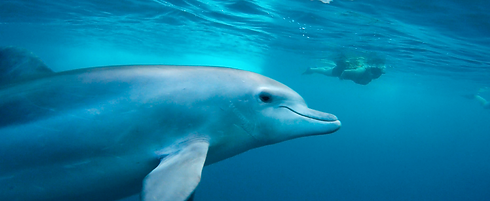top of page
CODE OF CONDUCT
DolphinCare
The DOLPHINCARE code was originally created for Dolphin Encountours in collaboration with the Centre of Dolphin Studies in SA, the Museum de Historia Natural, Universidade Eduardo Mondlane & International Dolphin Watch UK. It is based on research findings obtained from longterm fieldwork that has a reliable, repeatable and recordable methodology for observing dolphins in the wild.
The code is a standard operating procedure that offers participants in commercial dolphin swims knowledge and skills that can empower best practice for in-water observations of wild dolphins. We refer to this code in preparation for, during and after in-water observations of wild dolphins.
A. GULLAN, A GUISSAMULO, S. GULLAN, S. WEST, D. ROCHA.
2017 VERSION UPDATED FROM ORIGINAL CREATED IN 1996.

STANDARD OPERATING
Age and weight restrictions.
No children under the age of 5.
Weight less than 140kg
Welcome & introduction to the species found.
-
Explain different species encountered in the Reserve, characteristics and abundance.
-
The encounter is solely based on behaviour and certain individuals within the pod.
-
Address important behaviours like avoidance, resting, socialising, foraging etc.
Boat, snorkel & safety briefing.
-
Non- swimmers are not permitted water entry.
-
It is advisable to do a snorkelling practice session first before participants enter into open-water.
-
Participants are instructed on boating seating, safety and regulations.
-
Participants are to be calm and quiet at all times.
-
Under no circumstances swim under the boat or in front of it.
-
Move around the back staying clear of the motors.
-
Do not swim inshore into the waves, swim parallel to the shore line.
Water entry and swim postures.
-
Wait for the skippers instruction before getting off the boat..
-
Participants enter into the water gently slipping in legs first.
-
Once off the boat immediately move away and meet up with your guide.
-
No backward rolls or diving off the boat.
-
Participants are to float with their hands at side / behind their back and wait for the dolphins to approach.
What to expect when cetaceans are encountered.
-
The pod is approached slowly and data is collected.
-
Boat crew asses behaviour and likelihood of interaction. Participants are requested to prepare themselves for water entry.
-
Photo identification to be undertaken prior, during or after in-water observations.
-
Skippers are only permitted to drop twice on the same pod
-
*During peak season one pod, one drop per operator.
-
A one boat, no queue policy is to be followed, (in a single sighting, one boat may interact with dolphins at a time)
In-water conduct.
-
Participants are not permitted to touch, dive down or chase the dolphins.
-
Once in the water stay in a group with your guide/facilitator who has been trained on how to interact with the wild dolphins and monitor their behaviour.
-
Do not swim frantically at the dolphins, on top of them or after them.
-
Swim slowly and calmly causing as little turbulence as possible.
-
No scuba, underwater scooters, long self-sticks or camera flash.
Other
-
Avoidance, fighting & erratic herding; no water entry.
-
Newborns (<4 weeks) results in no water entry.
-
No water entry with resting dolphins*.
-
Swimming with whales is not promoted.
-
Every attempt should be made by crew NOT to interfere with behaviour.
-
Feeding and coaxing of dolphins is not permitted.
-
Corralling dolphins with the boat not permitted.
-
Breaking of code results in offender exiting water.
-
Do not litter


BLOG ON EMMT ➠➠

bottom of page
